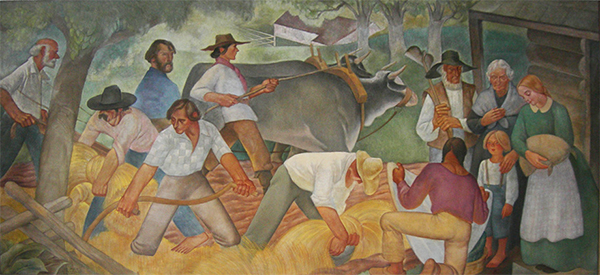During the course of the Forgotten Stories: Northwest Public Art in the 1930s exhibition, we have invited people to share the "Forgotten Stories" of the WPA artwork that they recall.
"Forgotten Stories" exhibition curator Margaret Bullock says “The extent of the federal art projects in the Northwest is surprising. We’ve long thought that the impact of the work was limited, but research has now shown that the projects in the Northwest were widespread and highly productive, employing over 600 artists resulting in thousands of artworks and offering art making opportunities to hundreds of thousands of Northwesterners.”
We hope you enjoy these "Forgotten Stories" and remembrances and thank everyone who shared their memories with us.
Carol Hayes
"I have in my collection, a mock-up and photograph of a mural painted by my father Carl Hall for the post office in Franklin, Kentucky. As there are no dates visible, I can't say whether it would fit into your exhibition. However, I do know that it was commissioned by the government. The finished mural was 11' 3 1/2" by 4' 1 1/2". The mock-up has been conserved and protected, but as it was painted on illustration board, it has succumbed to the years.
In the color mockup, the man with grey hair with his hands raised is a portrait of my father's father, Walter."
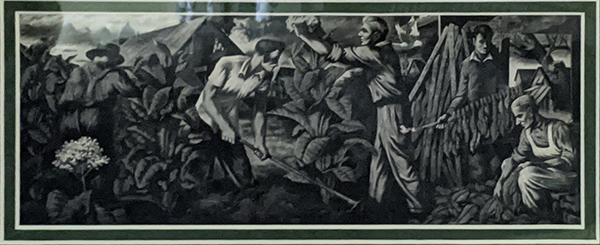
Carl Hall (American, 1921-1996), Photograph of a mural painted for the U.S. Government for the Franklin, Kentucky Post Office Mural, circa 1930s, photo courtesy of Carol Hayes.
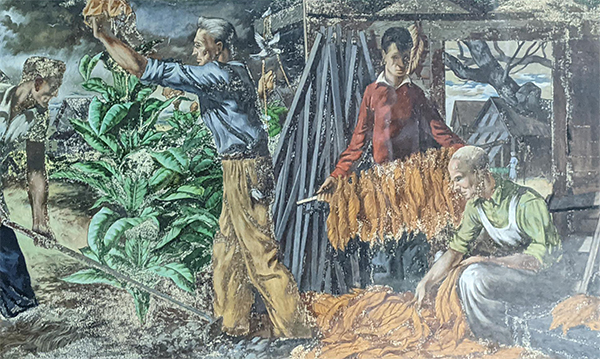
Carl Hall (American, 1921-1996), Mockup of a mural painted for the U.S. Government for the Franklin, Kentucky Post Office Mural, circa 1930s, paint on illustration board, photo courtesy of Carol Hayes.
Oregon artist Norma Heyser
"This is an unexpected, delightful memory. My best friend at Lincoln High School, somewhere in the early 1950s, was Jean Stanley, whose uncle Harry Wentz, lived “at the beach” with the Runquist brothers, Albert and Arthur. Uncle Harry's beautiful home and studios, designed by someone I should remember, was up Ocean Road atop the cliff of Neahkahnie Beach. The Last time I drove by, maybe a decade ago, it was there, still cared for and beautiful.
Our visits, maybe two, were adorable. “The boys” and Harry were gentle, sweet, somewhat awkward, appearing to not know what pleases high school girls. Polite, high-tea hospitality with chocolate cake was just right. They found comfort in grown-up exchange with the mature Stanleys.
Jean, we called her “Steamer”, telephoned me just a few weeks ago not having heard from each other for a very long time. You see, we are old now. We spoke about these visits because the Hallie Ford Museum of Art had asked for memories. Steamer said she remembers me talking intelligently with Uncle Harry because I was already some sort of teen-age artist."
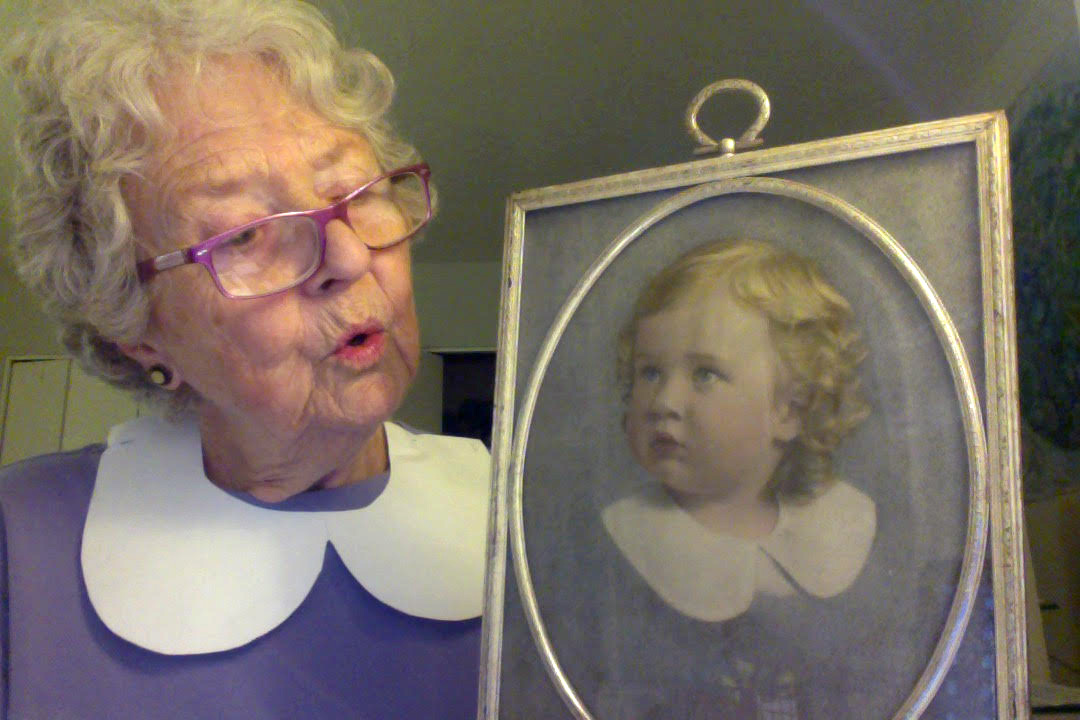
The Normas Discuss Life From 1933 to 2019, courtesy of Norma Heyser.
MORE ABOUT THE HARRY, ARTHUR AND ALBERT
- Henry (Harry) Frederick Wentz
- Arthur Runquist
- Albert Runquist
Deborah Heywood Halliburton
"My grandfather, Herbert Joseph Heywood, was a working artist all of his life. During the Depression years he did a number of projects including a mural on the ceiling of the Peninsula Park Community Center in North Portland. He went to the University of Oregon with the Runquist brothers and I have a quote from his journals concerning their work on the Tree of Life painting, that now is hanging at the University of Oregon.
My grandfather was friends with many of the WPA artists through their affiliation with the Portland Art Museum. His friend, Erich LaMade, painted a portrait of my grandfather in 1935."
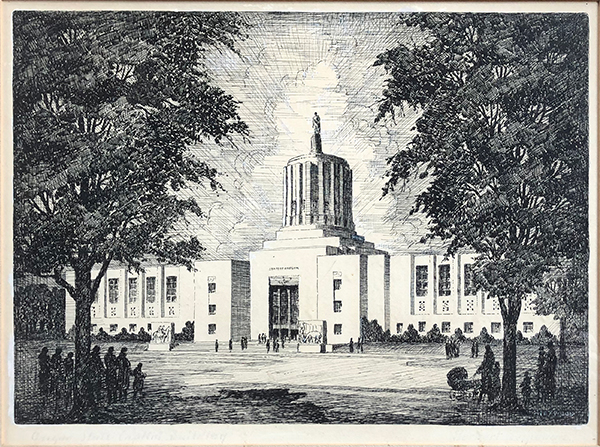
Pen and ink drawing of the Capitol building in Salem by Herbert Joseph Heywood and thought to be completed possibly in 1938. Photo courtesy of Deborah Heywood Halliburton.
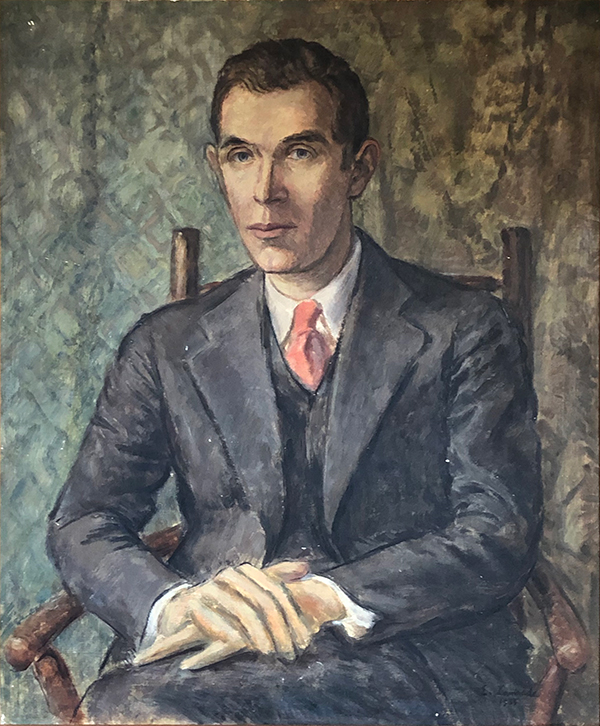
Portrait of Herbert Joseph Heywood painted by Erich Lamade, 1935. Photo courtesy of Deborah Heywood Halliburton.
Jan. 4, 1934
Start work for the C.W.A. today [I have no idea what organization this is and would love it if Margaret could tell me]. We have a choice of what to paint. I chose places of interest around and in Portland. $26-$42 a week . . .
Feb. 13, 1934
I am art director for the craftsmen in the C.W.A. project. Help in designs and give help on their work. I am getting a good deal from the craftsmen.
March 26, 1934
Working on a cartoon for a fresco mural for Peninsula Park playhouse - Athletes - track motif - half mile and high hurdles. Long narrow panel 3 ft. x 16 ft.
March 27, 1934
Went over to Foster and Kleiser today [outdoor sign company] to enlarge my sketch . . . Lantern casts sketch on paper on wall - 16 ft. long. Then used an "electric pencil" - put on "screen mesh" - The pencil burns small holes - hit with a bag of charcoal it leaves black dots on the wall to paint in with colors.
March 30, 1934
Went out to Peninsula Park today. Sized the walls with glue and pounced my design design on the walls. Outlined the design with sienna.
April 24, 1934
I find that in my fresco of dancing women I lose interest because I cannot realize what I feel. In the men I feel I have more nearly accomplished what I had intended. And yet in this same work the people who see the fresco like the dancing women better.
February 18, 1935
Erich Lamade is starting a portrait of me.
April 27, 1935 [Note: this is about the creation of the Tree of Life painting done by Arthur and Alfred Runquist for the University of Oregon].
Two artists, lying on their stomachs, on a platform 10" above their canvas. Such was the scene that greeted me as I went into the studio of Art and Al Runquist. They are doing a mural for the library of the U. of O. The room was not high enough for the canvas so they are doing it on the floor - on this low, movable platform.
What a difference in the artist who works and the dilletante who dabbles. These two fellows are doing a fine mural and they were dressed in overalls and sweat-shirts - the costume of the laborer.
They have been working about four months on the sketches and cartoons and the time limit is about up - W.P.A. project - and they are just beginning their flat color on the canvas. They are being pressed from all sides and are nervous and upset about it all.
Their mother fell and broke her hip bone - doctor bills and hospital bills are coming in. The landlord threatens to put them out of their house, the studio rent is owing - the government (W.P.A.) agent is pressing them and they are expected to do their best work under these conditions.
One reason why nothing worthwhile is done now is because we are in too much of a hurry - the mechanical age has brought this condition about.
Michael Munk
"My parents, my sister and I lived in the first 20th century house on Council Crest in Portland on SW Mt Adams Drive from 1947, and I was the last to leave in 2016. I researched and wrote a history of the house and neighborhood before leaving and discovered that Charlotte Mish and her family were residents from 1917 to 1933."

Oldest house 20th century (1908) house on Council Crest in 1947. It was torn down and replaced in 2016, courtesy of Michael Munk.
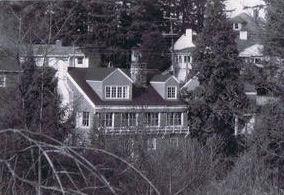
Looking East in 1947, courtesy of Michael Munk.
The excerpt:
Built in 1908-9, by 1917 the house had its third (but first longtime) owners — Robert Coleman Mish ( -1945) and his wife Lottie ( -1938) — who were living there with their daughter Charlotte Roberta Mish ( 1896-1974). The Mishs would stay a while. Robert Mish was then a deputy manager at Macky Company, and had lived with his family for the previous two years around the corner at 3804 SW Council Crest Drive. City Directories show her parents living in the house through 1933, but Charlotte, already a "writer and artist" was downtown, and the Directory shows no Mishs were left on Mt Adams Drive by 1934. Press accounts, however, have Charlotte living in the house with her crusading animal rights cousin Graziella Boucher (1894-1984) until 1935.
Charlotte had studied with Portland artist Sydney Bell and with Frank Vincent DuMond at the NY Art Students League. Best known for her Portland ship and port scenes, her paintings were bought by President Franklin Roosevelt's family and by Henry Kaiser. She created work for the WPA, including murals in Portland City Hall, the Oregon State Library, the United Seamen's Recreation Center in 1944 — when she worked at Albina Engine and Machine Works shipyards — Tongue Point Naval Air Station, the former Congress Hotel (1947), the Oyster Loaf restaurant (1949) and an "Aesop's Fables" mural in 1950 in Fox's bar at SE Milwaukie and Bybee. She was also a poet and member of the Oregon WPA’s Writers Project. In her later years, she and Graziella were often in the press as a pair of militant animal rights activists. One of her Portland dockside paintings hung in the house during my tenure.

From the Exhibition:
Charlotte Mish, (American, 1896-1974), Map of Oregon Flora, 1939, oil and tempera on panel, 54 x 72 in., State Library of Oregon, Salem, WPAEX-520.
Heidi Preuss Grew
"I thought I’d share this WPA painting in my hometown post office. Elmhurst, Illinois.
This mural is seared in my memory. I looked at it many times in my life as a child through my early adulthood."
George Melville Smith, "There was vision," 1938. Elmhurst, Illinois Post Office.


